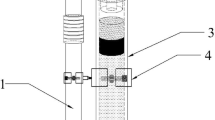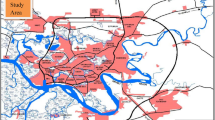Abstract
Hydrocarbon contaminants can enter the soil for various reasons and in addition to the potential for groundwater pollution, altering the characteristics of the soil, endangering already-existing structures on the soil, and endangering the health of living organisms, they can remain in the soil for a long time and have long-term effects on the environment. Therefore, it is crucial to manage, control, and treat the contaminated soil. To detect and monitor the contamination is a prerequisite of management and planning for the control and treatment of contaminated soil. One technique that has established its effectiveness in this area is electrical resistivity tomography (ERT). Despite the previous studies that demonstrate the proper performance of this method in identifying crude oil contamination in the soil, the accuracy of this method in identifying different concentrations of contaminants and the impact of soil moisture on the performance of this method remain two open questions that require further research. In this study, laboratory tests were conducted to answers to the two concerns mentioned above as well as the potential for developing an alternative technique of sampling and chemical testing to determine the contaminant concentration based on one-dimensional electrical resistivity. The findings of this study demonstrated that, despite this method’s good performance in locating crude oil contamination in sandy soil, it cannot be used to locate pollutants with low concentrations. Additionally, 1D tests along with the pseudo-section obtained from ERT were suggested as a suitable alternative (cheaper and faster) for sampling and chemical tests to identify the pollutant concentration and also the increase in soil moisture increases the minimum pollutant concentration that can be detected by this method.











Similar content being viewed by others
Data Availability
All data generated or analyzed during this study are included in this published article.
References
Akpan, A. E., Ebong, E. D., & Emeka, C. N. (2015). Exploratory assessment of groundwater vulnerability to pollution in Abi, southeastern Nigeria, using geophysical and geological techniques. Environmental Monitoring and Assessment, 187, 1–18.
Ansari, S., Norooz, R., Zeynolabedin, A., Foadi, H., & Ghiassi, R. (2021). Experimental investigation of correlations between electrical resistivity, moisture content and voltage values for leachate contaminated clayey sand. Journal of Applied Geophysics, 193, 104391.
Atekwana, E. A., Sauck, W. A., & Werkema, D. D., Jr. (2000). Investigations of geoelectrical signatures at a hydrocarbon contaminated site. Journal of Applied Geophysics, 44, 167–180.
Ayolabi, E., Folorunso, A., & Idem, S. (2013). Application of electrical resistivity tomography in mapping subsurface hydrocarbon contamination. Earth Science Research, 2, 93–104. https://doi.org/10.5539/esr.v2n1p93
Bichet, V., Grisey, E., & Aleya, L. (2016). Spatial characterization of leachate plume using electrical resistivity tomography in a landfill composed of old and new cells (Belfort, France). Engineering Geology, 211, 61–73.
Cassiani, G., Binley, A., Kemna, A., Wehrer, M., Orozco, A. F., Deiana, R., Boaga, J., Rossi, M., Dietrich, P., & Werban, U. (2014). Noninvasive characterization of the Trecate (Italy) crude-oil contaminated site: Links between contamination and geophysical signals. Environmental Science and Pollution Research, 21, 8914–8931.
Coria, D., Bongiovanni, V., Bonomo, N., de la Vega, M., & Garea, M. T. (2009). Hydrocarbon contaminated soil: Geophysical-chemical methods for designing remediation strategies. Near Surface Geophysics, 7, 227–236.
Dahlin, T., Bernstone, C., & Loke, M. H. (2002). A 3-D resistivity investigation of a contaminated site at Lernacken, Sweden. Geophysics, 67, 1692–1700.
Delaney, A. J., Peapples, P. R., & Arcone, S. A. (2001). Electrical resistivity of frozen and petroleum-contaminated fine-grained soil. Cold Regions Science and Technology, 32, 107–119.
Godio, A., & Naldi, M. (2003). Two-dimensional electrical imaging for detection of hydrocarbon contaminants. Near Surface Geophysics, 1, 131–137.
Griffin, T. W., & Watson, K. W. (2002). A comparison of field techniques for confirming dense nonaqueous phase liquids. Groundwater Monitoring & Remediation, 22, 48–59.
Halihan, T., Albano, J., Comfort, S. D., & Zlotnik, V. A. (2012). Electrical resistivity imaging of a permanganate injection during in situ treatment of RDX-contaminated groundwater. Groundwater Monitoring & Remediation, 32, 43–52.
Heenan, J., Slater, L. D., Ntarlagiannis, D., Atekwana, E. A., Fathepure, B. Z., Dalvi, S., Ross, C., Werkema, D. D., & Atekwana, E. A. (2015). Electrical resistivity imaging for long-term autonomous monitoring of hydrocarbon degradation: Lessons from the deepwater horizon oil spill. Geophysics, 80, B1–B11.
Koroma, S., Arato, A., & Godio, A. (2015). Analyzing geophysical signature of a hydrocarbon-contaminated soil using geoelectrical surveys. Environmental Earth Sciences, 74, 2937–2948.
Loke, M., & Barker, R. (1996). Practical techniques for 3D resistivity surveys and data inversion1. Geophysical Prospecting, 44, 499–523.
Masy, T., Caterina, D., Tromme, O., Lavigne, B., Thonart, P., Hiligsmann, S., & Nguyen, F. (2016). Electrical resistivity tomography to monitor enhanced biodegradation of hydrocarbons with Rhodococcus erythropolis T902. 1 at a pilot scale. Journal of Contaminant Hydrology, 184, 1–13.
Meng, F., Wang, J., Chen, Z., Qiao, F., & Yang, D. (2023). Shaping the concentration of petroleum hydrocarbon pollution in soil: A machine learning and resistivity-based prediction method. Journal of Environmental Management, 345, 118817.
Nazifi, H. M., Gülen, L., Gürbüz, E., & Pekşen, E. (2022). Time-lapse electrical resistivity tomography (ERT) monitoring of used engine oil contamination in laboratory setting. Journal of Applied Geophysics, 197, 104531.
Pujari, P. R., Pardhi, P., Muduli, P., Harkare, P., & Nanoti, M. V. (2007). Assessment of pollution near landfill site in Nagpur, India by resistivity imaging and GPR. Environmental Monitoring and Assessment, 131, 489–500.
Raji, W. O., Obadare, I. G., Odukoya, M. A., & Johnson, L. M. (2018). Electrical resistivity mapping of oil spills in a coastal environment of Lagos, Nigeria. Arabian Journal of Geosciences, 11, 1–9.
Rhoades, J., & van Schilfgaarde, J. (1976). An electrical conductivity probe for determining soil salinity. Soil Science Society of America Journal, 40, 647–651.
Rosales, R. M., Martínez-Pagan, P., Faz, A., & Moreno-Cornejo, J. (2012). Environmental monitoring using electrical resistivity tomography (ERT) in the subsoil of three former petrol stations in SE of Spain. Water, Air, & Soil Pollution, 223, 3757–3773.
Samouëlian, A., Cousin, I., Tabbagh, A., Bruand, A., & Richard, G. (2005). Electrical resistivity survey in soil science: A review. Soil and Tillage Research, 83, 173–193.
Shao, S., Guo, X., Gao, C., & Liu, H. (2021). Quantitative relationship between the resistivity distribution of the by-product plume and the hydrocarbon degradation in an aged hydrocarbon contaminated site. Journal of Hydrology, 596, 126122.
Simyrdanis, K., Papadopoulos, N., Soupios, P., Kirkou, S., & Tsourlos, P. (2018). Characterization and monitoring of subsurface contamination from olive oil mills’ waste waters using electrical resistivity tomography. Science of the Total Environment, 637, 991–1003.
Son, Y. (2011). Assessment of concentration in contaminated soil by potentially toxic elements using electrical properties. Environmental monitoring and assessment, 176, 1–11.
Srinivasamoorthy, K., Vijayaraghavan, K., Vasanthavigar, M., Rajivgandhi, R., & Sarma, V. (2011). Integrated techniques to identify groundwater vulnerability to pollution in a highly industrialized terrain, Tamilnadu, India. Environmental Monitoring and Assessment, 182, 47–60.
Wang, T.-P., Chen, C.-C., Tong, L.-T., Chang, P.-Y., Chen, Y.-C., Dong, T.-H., Liu, H.-C., Lin, C.-P., Yang, K.-H., & Ho, C.-J. (2015). Applying FDEM, ERT and GPR at a site with soil contamination: A case study. Journal of Applied Geophysics, 121, 21–30.
Xia, T., Ma, M., Huisman, J. A., Zheng, C., Gao, C., & Mao, D. (2023). Monitoring of in-situ chemical oxidation for remediation of diesel-contaminated soil with electrical resistivity tomography. Journal of Contaminant Hydrology, 256, 104170.
Yang, P., Liu, Y.-H., Zhang, S.-H., & Pan, Y.-F. (2019). Experimental investigation on the migration of leachate under flowing conditions through laboratory ERT. Environmental Science and Pollution Research, 26, 17457–17471.
Zogala, B., Dubiel, R., Zuberek, W., Rusin-Zogala, M., & Steininger, M. (2009). Geoelectrical investigation of oil contaminated soils in former underground fuel base: Borne Sulinowo, NW Poland. Environmental Geology, 58, 1–9.
Author information
Authors and Affiliations
Corresponding author
Ethics declarations
Competing Interests
The authors declare no competing interests.
Additional information
Publisher’s Note
Springer Nature remains neutral with regard to jurisdictional claims in published maps and institutional affiliations.
Rights and permissions
Springer Nature or its licensor (e.g. a society or other partner) holds exclusive rights to this article under a publishing agreement with the author(s) or other rightsholder(s); author self-archiving of the accepted manuscript version of this article is solely governed by the terms of such publishing agreement and applicable law.
About this article
Cite this article
Amani, S., Keshtdar, A. & Ghiassi, R. Investigation of the Effectiveness of Electrical Resistivity Tomography in Monitoring and Detecting Hydrocarbon Contamination in Sandy Soil at Various Moisture: Pilot Scale. Water Air Soil Pollut 235, 175 (2024). https://doi.org/10.1007/s11270-024-06984-y
Received:
Accepted:
Published:
DOI: https://doi.org/10.1007/s11270-024-06984-y




